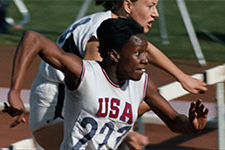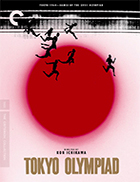Tokyo Olympiad (Tôkyô orinpikku)
|  Tokyo Olympiad (Tôkyô orinpikku), Kon Ichikawa’s deeply humanistic documentary of the 1964 Olympic games in Tokyo, Japan, almost wasn’t. Initially rejected as “too artistic” by the Japanese Olympic Committee, which was looking for a more traditional news-style documentary that focused on Japanese medal winners and the newly modernized city of Tokyo, Ichikawa’s documentary was temporarily caught in a political crossfire that centered on one of the great paradoxes of documentary filmmaking: Is the filmmaker there to simply record, or is he or she there to interpret? Thankfully, Ichikawa’s masterpiece survived the ordeal, which in hindsight looks silly, especially given the magnificent nature of the film. Unconventional, yes. But, it is that very unconventional nature, one that came directly from Ichikawa’s unique sensibilities as a postwar Japanese filmmaker, that makes Tokyo Olympiad so memorable and unique. (Owing to the controversy surrounding it, Tokyo Olympiad circulated over the years in a number of shortened versions, and Ichikawa’s original 170-minute cut remained unseen in the U.S. until the 1984 New York Film Festival.) Every Olympiad commissions an official film, and most of them are interchangeable reports on who won what. Few, if any, reach deep into the Olympics and celebrate not only the real goal of the games—to bring together people from all nationalities and ethnicities in competitions of goodwill—but also the humanity of the competitors. Ichikawa’s cameras seek out and elucidate not just athletes of great prowess, but the painful human dimensions of competition, which means that the film focuses on the losers just as often as the winners. Tokyo Olympiad opens with the first of three shots of a blazing orange sun, then cuts directly to footage of wrecking balls tearing down old buildings to make way for the new Olympic Stadium. While almost all previous Olympic documentaries open in ancient Greece in order to evoke the rich history of the games, Ichikawa opts to do something different by underscoring the interplay between destruction and rebuilding, something that would strike deep chords with the Japanese people, who were still struggling out from underneath the physical and economic devastation of World War II. Ichikawa then follows the ceremonial Olympic torch, starting with its being lit by the rays of the sun in Greece and ending with its being carried into the Olympic Stadium as part of the opening ceremony. It is here that Ichikawa gives us some of the first truly monumental imagery in a film that will be filled with much more, including a glorious wide shot of Mount Fuji with the Olympic torch bearer a tiny speck at the bottom of the screen, as well as a helicopter shot of the torch being carried through Hiroshima, still filled with the skeletal remains of destroyed buildings—again a reminder of the cycle of destruction and rebuilding. The majority of the film, however, is given over to coverage of the various competitions. Ichikawa does not cover every sport, but he covers the majority of them, giving extended screen time to certain ones (including women’s volleyball, the pole vault, the marathon, and cycling), while conveying others in fragmentary montage. Ichikawa had an enormous staff working for him—100 cameras operated by 164 cameramen who shot more than 400,000 feet of film, which is roughly 74 hours of footage, of which Ichikawa personally supervised the editing down to 170 minutes. There are two technical components that Ichikawa used to great effect. The first is the wide CinemaScope aspect ratio, which gives Tokyo Olympiad a more grandiose, cinematic canvas. Such widescreen aspect ratios were rarely used for sports documentaries, and Ichikawa found new and exciting ways to frame the action, particularly in his overhead shots of swim competitions and long shots of track races. Hand-in-hand with the CinemaScope frame is the use of the ultra-telephoto lens, which more than anything gives Tokyo Olympiad its unique feel. These lenses allowed Ichikawa’s cameramen to get in close to the action, to give us close-ups of the athletes’ faces and bodies in order to emphasize the heat of the competition, rather than the outcome. The film is a visual marvel of cinematic techniques, many of which were groundbreaking at the time in terms of what was acceptable for a sports documentary. Never satisfied with simply capturing the event on film, Ichikawa sought to convey more thoroughly the experience of the Olympics. Hence, he employs slow motion during the sprints so that we may see every flex of the athletes’ muscles, the tension on their faces, the desire in their eyes. To transition into gymnastics, he gives us an abstract image of a single gymnast against a black background, using slow motion and multiple exposures to further underscore the beauty of the physical movements. Sometimes he goes against conventional wisdom, for instance, shooting wrestling matches in such extreme close-up that, rather than feeling like you are watching the match, you feel like you are literally caught between the two competitors. At other points, he uses freeze frames, black and white, and various dissolves, and the soundtrack is replete with an almost avant-garde mixture of musical motifs, from eerie mood music, to lively Western jazz, to angelic choruses. To some, this may seem like too much, as if Ichikawa is trying to steal away the focus from the athletes and put it on himself as auteur. Granted, some of his techniques seem like cliché, but that is only because so many filmmakers have copied them in the years since. As a whole, Tokyo Olympiad, despite its often fragmentary nature, works, and Ichikawa’s techniques, although self-consciously artistic in many respects, are successful in exploring the fundamental nature of the Olympics, both its exhilaration and its heartbreak. Always a quirky filmmaker with a dark sense of humor, one can often feel Ichikawa reaching for the offbeat and the amusing, such as when his camera focuses in on the odd rituals athletes go through before competing or his bemused look at the visually silly nature of the walking event. In a sense, the Japanese Olympic committee was absolutely right in deploring Tokyo Olympiad because it did not live up to their expectations. While they wanted a rigorous, objective document of what transpired during those 17 days in Tokyo, Ichikawa, the prolific director of such diverse films as The Burmese Harp (1956), Fires on the Plain (1959), and An Actor’s Revenge (1963), delivered an idiosyncratic visual poem about human nature. For instance, while he skipped over entire Olympic events, he lavished large amounts of screen time to a single runner from the emerging African nation of Chad who didn’t even place in his event. Yet, it is such moments, much more than a simple record of who won what race, that gives us the true sense of what athletic competition is all about. In the long run, it is for the best that the Olympic Committee didn’t get what they wanted, because they got something much more.
Copyright © 2020 James Kendrick Thoughts? E-mail James Kendrick All images copyright © The Criterion Collection | |||||||||||||||||||||||||||||||
Overall Rating: 


 (4)
(4)


